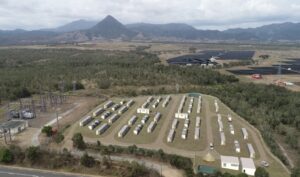In a hurry? Here’s the message
Batteries and Solar are competitive not just with peaking gas in the US, but with mid merit combined cycle gas under two main conditions:
(1) You count the ancillary revenue as well as the load shifting arbitrage. These values get counted for both the gas and BS combo. (I’ve deliberately called batteries and solar battery storage (BS) to get out in front of the haters) and;
(2) Batteries qualify for the investment tax [ITC] credit.
That’s my interpretation after reading a study by MBA students at Carnegie Mellon School of Business.
The study sponsor is Fluence (a utility scale battery technology provider). In terms of research quality that’s two black marks, students and a sponsor with an agenda. Despite the black marks, the study appears to be carefully done and in my view the results are worth noting and the implications for Australia worth considering.
Battery storage compared to combined cycle gas in the US
The White paper linked to on the Fluence site by Fluence lead data scientist Colleen Lueken can be found here BS v Gas whitepaper
In addition to including ancillary services as part of the revenue stream (in Australia a resources analyst would think of this as say an platinum or cobalt credit in a nickel plant) the study uses modern statistics to “cluster” gas plants.
Gas plants are clustered not on the basis of technology but on the basis of the job they do based on the generation profile. 5/6 gas plant clusters required 6 hour BS plants and one cluster a 4 hour BS plant.
The first piece of data I looked for was to see what battery costs were used. Of course, Fluence couldn’t tell them actual battery prices, more closely guarded secrets than the passcode on a teenager’s phone but the White Paper states in a footnote:
“We use $1,100 per kilowatt (kW) and $1,500/kW as capital costs for four-hour and six-hour duration storage, respectively, with commercial online dates of 2020”
These prices equate to roughly A$387 KWh and A$352 KWh or about a 10% decline in unit cost for a 50% increase in battery capacity. The numbers are also consistent with those touted round the industry by the likes of BNEF and Greentech, albeit mostly quoting each other.
A midmerit gas plant was more or less defined as one with a capacity factor less than 50%, that’s 270 or 62% of all US gas plants and would certainly cover most gas plants in Australia.
In the US batteries qualify for the Solar Investment Tax Credit. This allows a 30% of the capital cost of the system to be deducted from Federal US tax. Its being phased out, as has the tax credit for wind and will be down to 10% by 2022.
At 30% it’s worth about US$26.1/MWh. The figure below is for Arizona BS plant. The assumed capacity factor of the gas plant cluster in Arizona is 32%. Apologies for low resolution of image.

In this model the battery (cost of equity was an absurd 10%) Long run marginal cost is US$45.61 MWh or say A$63 MWh. Note that both the BS and gas plant are assumed to have 30 year lives. Of course we don’t think batteries will last for 30 years. It may be that there are some maintenance, in this case cell and inverter replacementcapex allowed for but if so it’s not explicitly mentioned.
On the other hand there doesn’t appear to be any revenue credit for spilled energy. It’s hard to understand that as we are still a long way from zero prices in the daylight hours
The BS plants still don’t necessarily match battery capacity fully with solar capacity factor. The following table shows the sizing medians used by the Whitepaper analysts for the Arizona plant calculations.

Assuming 31% capacity factor (AC) daily output is about 744 MWh so there’d be some surplus PV producing as available in the middle of the day.
US tax credits will be worth around US$9/MWh on both batteries and solar, but Australia has nothing
In Australia, the renewable energy target has been met. This means that at present there is no policy support for renewables. There is no policy support for batteries or pumped hydro. There is no carbon cost. Nothing, nothing, nothing. A big fat zero. Donald Trump’s US provides more support than the current Federal Govermment.
There is grant based state support in South Australia and Victoria for household battery storage systems. Perhaps you could argue there is support in NSW in form of cheap finance, but finance is cheap anyway and QLD has a token scheme although not to be mentioned within earshot of the CMFEU or ETU.
Translating the Arizona LCOE to Queesnsland or Northern NSW for an equivalent 100 MW/AC solar and 68/ 408 MWh storage system gets you to A$97 MWh (no ITC in Australia). Again this would presume significant ancillary service revenues (frequency management and spinning reserve management).
Before someone asks me how a battery provides an equivalent service a spinning reserve provides I don’t know exactly but I assume it’s via the inverter and by providing overall stability to ramping up and down of power. As the study points out frequency regulation is likely to become a competitive market in a hurry.
A$97/MWh for a battery storage system is arguably broadly competitive with a combined cycle gas plant in Australia operating at around 50% capacity factor and with A$9 GJ gas.
I’d point out that the conventional heat rate calculations (GJ/MWh) of a combined cycle do not explicitly account for part efficiency or efficiency during ramping. Such conditions won’t improve the heat rate but may or may not harm it much. The gas plant can run continuously but we continue to think that you can’t get much value out of those extra hours.
Following the lead of Paul Denholm at NREL, interviewed on our EnergyInsiders podcast early last year and also referenced in the White Paper reviewed here we see that batteries can do a great job at daily peak shaving.
Over the past 12 months the figure below shows that assuming good levels of ancillary service FCAS revenue its likely that NEM wide 2-3 GW of 5 hour storage would have earned a return and about 1 GW of 1.5 hour storage would have knocked down the $138-$148 MWh peak prices by say $15 MWh.
Of course with policy support at long term US levels for batteries this would be a better case and arguably relatively cheap carbon abatement.









